China Commercial Real Estate Market Size
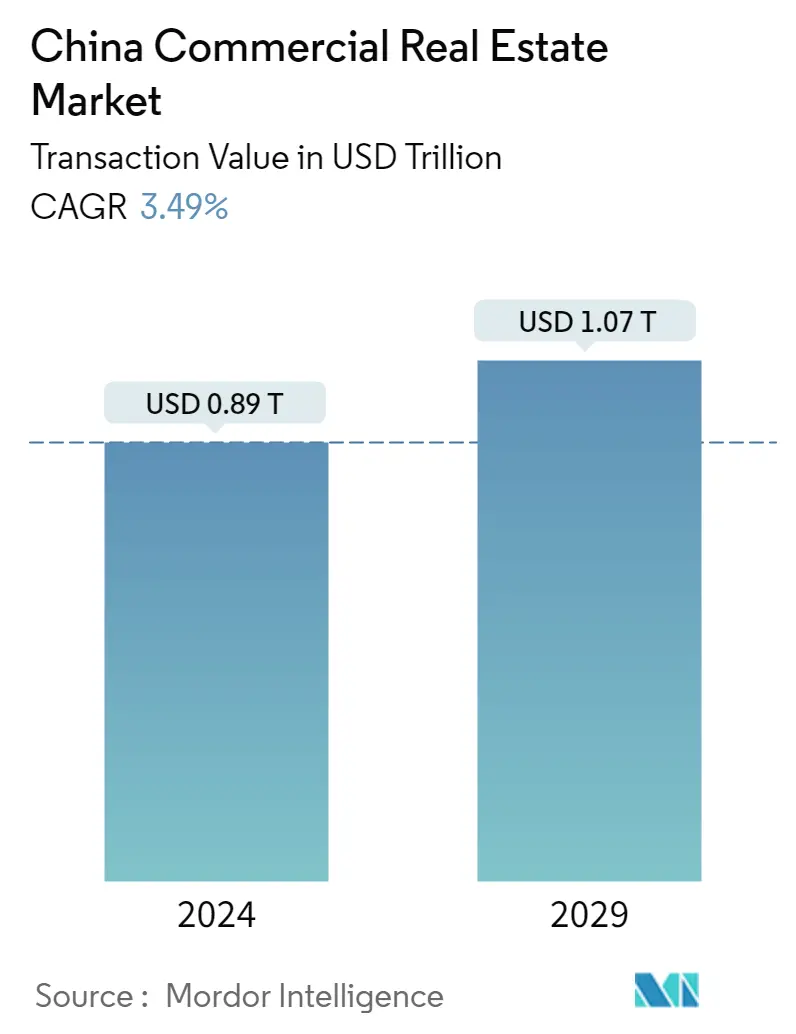
| Study Period | 2019 - 2029 |
| Base Year For Estimation | 2023 |
| Market Size (2024) | USD 0.89 Trillion |
| Market Size (2029) | USD 1.07 Trillion |
| CAGR (2024 - 2029) | 3.49 % |
| Market Concentration | Low |
Major Players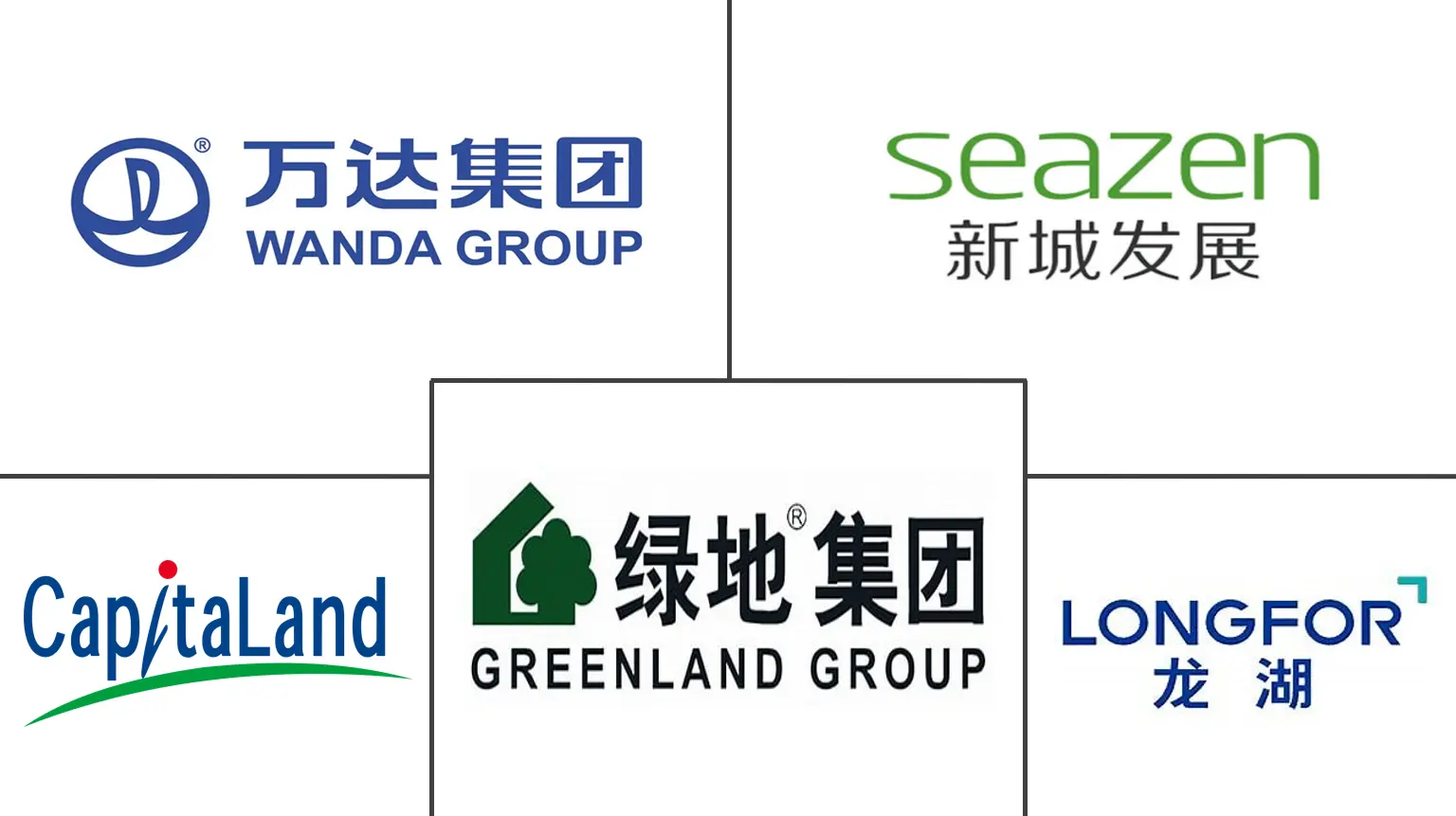
*Disclaimer: Major Players sorted in no particular order |
China Commercial Real Estate Market Analysis
The China Commercial Real Estate Market size in terms of transaction value is expected to grow from USD 0.89 trillion in 2024 to USD 1.07 trillion by 2029, at a CAGR of 3.49% during the forecast period (2024-2029).
For the office market, nationwide net absorption is estimated to reach 6.2 million square meters in 2022, well above the five-year average of 5.3 million square meters. Technology and finance sectors are expected to continue being the primary drivers of office demand.
- COVID-19 significantly impacted China's commercial real estate market. This is due to high vacancy rates in offices and shopping malls in major cities such as Beijing, Shanghai, Guangzhou, and Shenzhen.
- Additionally, the slowing economy has led to a decline in demand for offices and shopping malls, followed by a drop in customer flows, impacting shopping mall rental charges. It is estimated that China's economy will normalize in 2022, with a GDP growth of roughly 5% Y-o-Y. Counter-cyclical policies and structural transformations are being implemented to ensure sustained growth.
- Logistics net absorption is estimated to exceed 6 million square meters for the second year in 2022 due to the increase in space take-up by e-commerce companies, third-party logistics expansion, and the introduction of the Regional Comprehensive Economic Partnership (RCEP) scheme. Further, more cities in China are expected to shift to a balanced or landlord-favourable markets.
China Commercial Real Estate Market Trends
Technology and Innovation Driving the Market
With a growing requirement for technology adoption, Chinese real estate companies are using a variety of innovative approaches to improve their technical skills while remaining competitive. Additionally, some prominent Chinese commercial real estate developers have partnered with internet and tech giants such as Alibaba, Tencent, JD, and Huawei to increase the adoption of property technology for efficient business operations. These developers can take advantage of the R&D capabilities of the tech companies while sharing business insights and giving physical space and financial resources as part of the partnership.
Chinese consumers' preferences are driving China's innovation in real estate. China has emerged as a major player in many digital technologies, particularly in consumer-facing industries and Fintech. Regarding the number of unicorns and valuations, China's property technology market is catching up to that of the United States. Moreover, 75% of property technology start-ups are in Beijing, Shanghai, Shenzhen, and Hangzhou.
Companies in Tier 1 cities are more likely to be early adopters of property technology solutions. These customers are associated with the brand, the quality of the product, the level of service, and personalized engagement. Customers will begin to demand omnichannel options and experiences as Alibaba's Hema and other similar retail innovations become more prevalent.
Property technology start-ups with data on customers, properties, sales, and business operations can use it to build new product offerings and assist businesses with decision-making. Chinese start-ups may lead the world in consumer-facing property technology, physical retail innovation, and 5G-related applications.
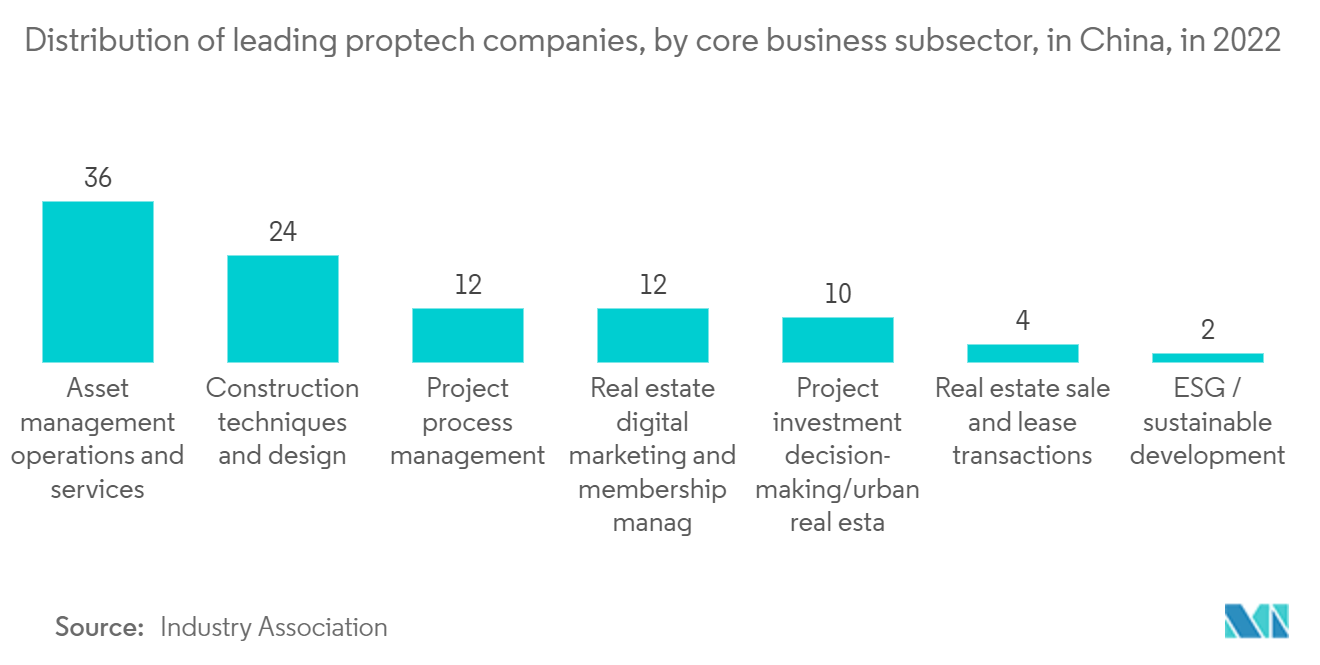
Growth in Start-ups Driving the Office Market
As of 2021, the sectors with the most unicorns in China were technology and telecommunications, transportation and logistics, and the finance or insurance sector. Chinese unicorns in the finance or insurance sector have a significantly higher market valuation than start-ups from other sectors.
Currently, China has 4,762 national-level giant companies and over 40,000 provincial-level giant firms. More than 300 little giant companies, such as XGIMI, are listed on various exchanges. Even during the COVID-19 pandemic, they maintained a positive growth rate and relatively high capital expenditure, demonstrating that such companies were less affected by the pandemic while continuing to grow rapidly.
The Ministry of Industry and Information Technology announced in March 2022 that it would support incubating an additional 3,000 little giant companies this year. China aims to create 10,000 little giant companies and 1,000 single-product champion enterprises in two years. By that time, similar companies are expected to contribute to innovations and provide momentum to China's future economic growth.
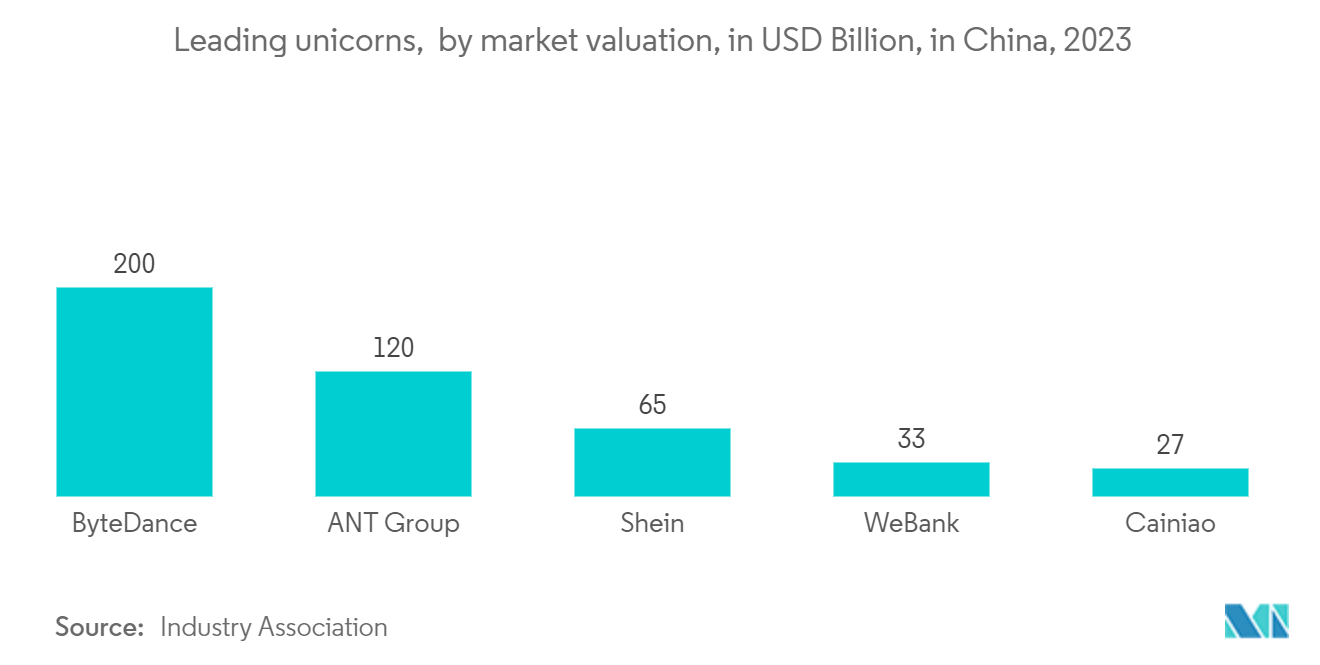
China Commercial Real Estate Industry Overview
The Chinese commercial real estate market is slightly fragmented, with the presence of a large number of players. Some of the major players include Wanda Group, GreenLand Group, Seazen, and CapitalLand. The market is characterized by the presence of large players and emerging players in the market. At the same time, players in the residential real estate market are also diversifying to invest in the commercial real estate market in China. Foreign investment has increased, so foreign players are also entering the competitive scene.
China Commercial Real Estate Market Leaders
-
Wanda Group
-
Seazen Holdings Co
-
GreenLand Group
-
CapitalLand
-
Longfor
*Disclaimer: Major Players sorted in no particular order
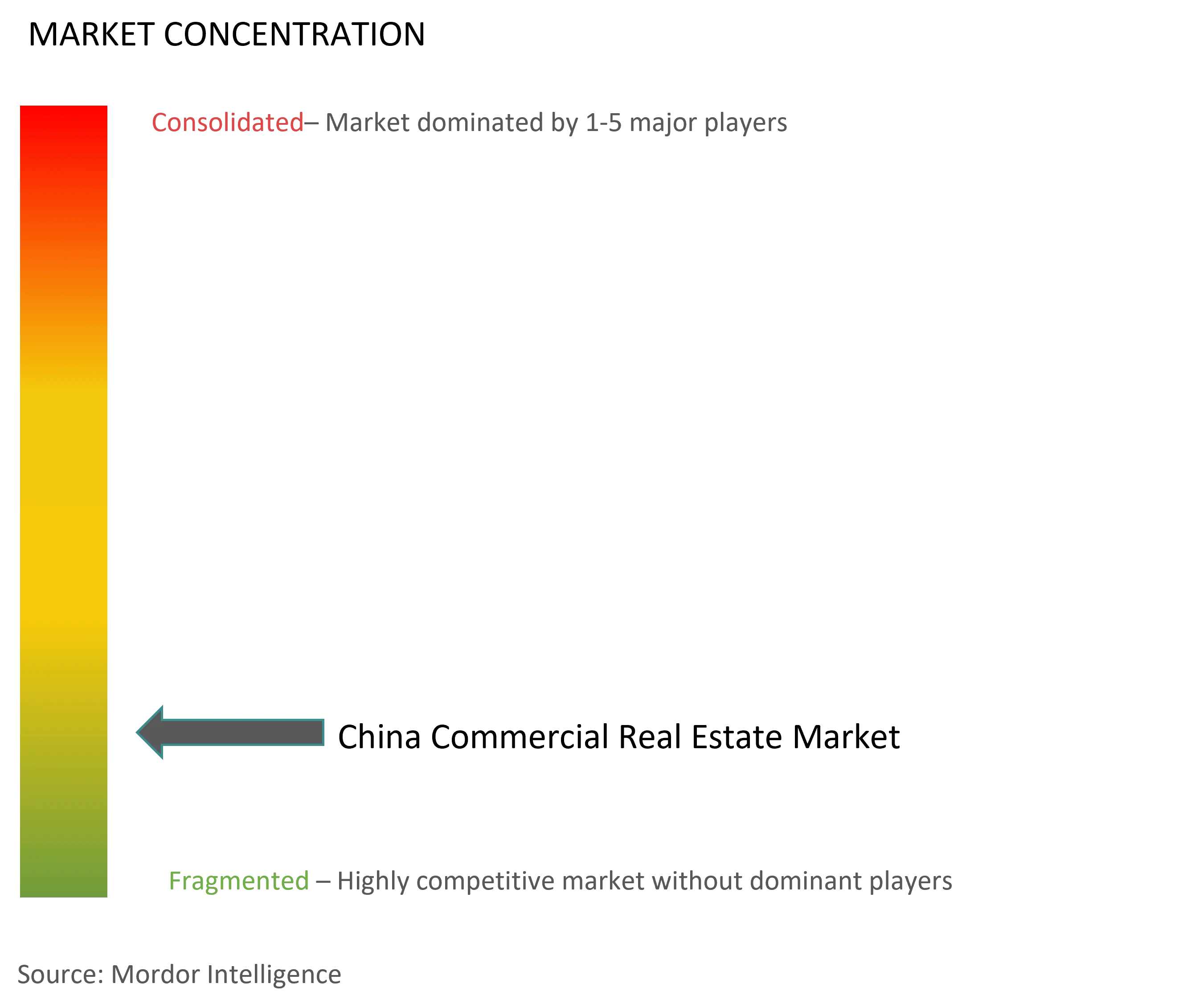
China Commercial Real Estate Market News
- May 2023: The Beijing Suning Life Plaza mixed-use complex was recently purchased from Suning for about USD 400 million by CapitaLand Investment Private Fund with the help of Cushman & Wakefield's Greater China Capital Markets division.
- April 2023: AIA put US$1.3 billion into a Shanghai office-retail complex, while Ping An paid about US$7 billion for industrial and office assets in Shanghai and Beijing. Insurers, including AIA and Ping An Life Insurance, are investing billions of dollars in mainland China properties, which are expected to remain an attractive asset class for insurers despite the property market downturn.
China Commercial Real Estate Market Report - Table of Contents
1. INTRODUCTION
- 1.1 Study Assumptions and Market Definition
- 1.2 Scope of the Study
2. RESEARCH METHODOLOGY
3. EXECUTIVE SUMMARY
4. MARKET INSIGHTS
- 4.1 Current Market Scenario
- 4.2 Value Chain/Supply Chain Analysis
- 4.3 Government Initiatives and Regulatory Aspects for the Commercial Real Estate Sector
- 4.4 Commercial Real Estate Buying Trends - Socioeconomic and Demographic Insights
- 4.5 Insights on Existing and Upcoming Projects
- 4.6 Insights on Interest Rate Regime for the General Economy and Real Estate Lending
- 4.7 Insights on Rental Yields in the Commercial Real Estate Segment
- 4.8 Insights on Capital Market Penetration and REIT Presence in Commercial Real Estate
- 4.9 Insights on Public-Private Partnerships in Commercial Real Estate
- 4.10 Insights on Real Estate Tech and Startups Active in the Real Estate Segment (Broking, Social Media, Facility Management, and Property Management)
- 4.11 Impact of COVID-19 on the Market
5. MARKET DYNAMICS
-
5.1 Market Drivers
- 5.1.1 Foreign Investments driving the market
- 5.1.2 Implementation of government policies driving the market
-
5.2 Market Restraints
- 5.2.1 Oversupply of commercial real estate
- 5.2.2 Increasing property prices affecting the growth of the market
-
5.3 Market Opportunities
- 5.3.1 Growth of the logistics industry
- 5.3.2 Increasing urbanization contributing to the growth of the market
-
5.4 Industry Attractiveness - Porter's Five Forces Analysis
- 5.4.1 Bargaining Power of Suppliers
- 5.4.2 Bargaining Power of Buyers/Consumers
- 5.4.3 Threat of New Entrants
- 5.4.4 Threat of Substitute Products
- 5.4.5 Intensity of Competitive Rivalry
6. MARKET SEGMENTATION
-
6.1 By Type
- 6.1.1 Office
- 6.1.2 Retail
- 6.1.3 Industrial (Logistics)
- 6.1.4 Hospitality
7. COMPETITIVE LANDSCAPE
- 7.1 Market Concentration Overview
-
7.2 Company Profiles
- 7.2.1 Wanda Group
- 7.2.2 Greenland Business Group
- 7.2.3 Seazen Holdings Co. Ltd
- 7.2.4 CapitaLand
- 7.2.5 Longfor
- 7.2.6 China Resources Land Limited
- 7.2.7 Powerlong Real Estate Holdings Limited
- 7.2.8 China Aoyuan Group Ltd
- 7.2.9 Wharf Real Estate Investment Company Limited
- 7.2.10 Sun Hung Kai Properties Limited
- 7.2.11 Henderson Land Development Company Limited
- 7.2.12 Prologis*
- *List Not Exhaustive
8. FUTURE OF THE MARKET
9. APPENDIX
** Subject To AvailablityChina Commercial Real Estate Industry Segmentation
Commercial real estate (CRE) is a property used solely for business or to provide a workspace rather than for residential purposes. Commercial real estate is often leased to tenants to conduct income-generating activities.
A complete background analysis of the China Commercial Real Estate Market, including the assessment of the economy and contribution of sectors in the economy, market overview, market size estimation for key segments, and emerging trends in the market segments, market dynamics, and geographical trends, and COVID-19 impact is included in the report.
The Report Covers Commercial Real Estate Companies in China and the Market is Segmented by Type (office, Retail, Industrial (Logistics), and Hospitality). The Report Offers Market Size and Forecasts for the China Commercial Real Estate Market in Value (USD) for all the Above Segments.
| By Type | Office |
| Retail | |
| Industrial (Logistics) | |
| Hospitality |
China Commercial Real Estate Market Research FAQs
How big is the China Commercial Real Estate Market?
The China Commercial Real Estate Market size is expected to reach USD 0.89 trillion in 2024 and grow at a CAGR of 3.49% to reach USD 1.07 trillion by 2029.
What is the current China Commercial Real Estate Market size?
In 2024, the China Commercial Real Estate Market size is expected to reach USD 0.89 trillion.
Who are the key players in China Commercial Real Estate Market?
Wanda Group, Seazen Holdings Co, GreenLand Group, CapitalLand and Longfor are the major companies operating in the China Commercial Real Estate Market.
What years does this China Commercial Real Estate Market cover, and what was the market size in 2023?
In 2023, the China Commercial Real Estate Market size was estimated at USD 0.86 trillion. The report covers the China Commercial Real Estate Market historical market size for years: 2019, 2020, 2021, 2022 and 2023. The report also forecasts the China Commercial Real Estate Market size for years: 2024, 2025, 2026, 2027, 2028 and 2029.
What trends are emerging in the China Commercial Real Estate Market?
The trends emerging in the China Commercial Real Estate Market are a) The growth of coworking spaces and development of large-scale commercial projects in tier 1 cities b) Rising preference for mixed-use developments combining office spaces with retail and entertainment options
How is the China Commercial Real Estate Market segmented?
The China Commercial Real Estate Market is segmented by type, including office, retail, industrial, logistics, multi-family, and hospitality.
Chinese Commercial Real Estate Industry Report
The China Commercial Real Estate Market has seen significant growth and transformation, driven by evolving customer preferences, market trends, and macroeconomic factors. Segmented by property types such as offices, logistics, industrial, retail, hotels, and multifamily properties, the market caters to a broad spectrum of business needs. A notable increase in demand for high-end office spaces in major cities highlights the impact of rapid urbanization and the rising middle class. Modern buildings with advanced technology and amenities are in demand, reflecting a shift towards spaces supporting multinational corporations, technology companies, and startups. Mixed-use developments combining office spaces with retail, dining, and entertainment options are also popular, creating vibrant environments. This growth is supported by government policies promoting stability and sustainable growth, alongside initiatives like the Belt and Road Initiative. The strong economic growth, urbanization, and expanding consumer market in China continue to drive demand for commercial spaces, with China commercial real estate companies playing a crucial role in developing innovative and high-quality projects. For detailed statistics on market share, size, and revenue growth rate, Mordor Intelligence™ Industry Reports offer a comprehensive analysis, including market forecasts and historical overviews, available as a free report PDF download.



